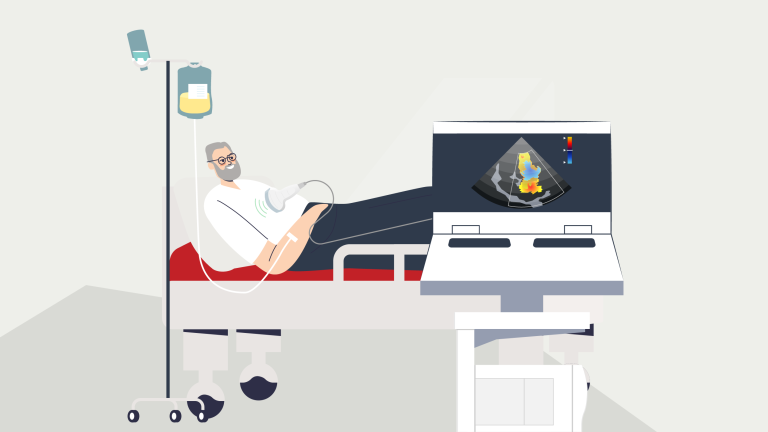
Vancouver Coastal Health (VCH) is seeking to implement a Point of Care Ultrasound (PoCUS) device in their long-term care (LTC) facilities to treat residents at the bedside. Access to PoCUS in a LTC setting can expedite diagnoses or rule out serious conditions, potentially eliminating the need for hospital visits.
Statistics show that 46 per cent of people living in LTC that are sent to the Emergency Department (ED) are admitted alongside the various hospital-acquired ailments; the goal is for VCH to implement PoCUS to provide accessible, timely, and precise diagnostics, leading to tailored and person-centered treatment decisions.
Vancouver Coastal Health is posting this Call for Innovation to seek out qualified Canadian companies
who can meet the desired outcomes. Vancouver Coastal Health and CAN Health reserves the right to not
move forward with this project at its full discretion and in particular if there are no qualified Canadian
companies that can reasonably meet the desired outcomes.
To qualify for a CAN Health project, the company must have its headquarters in Canada and/or the majority (>50%) of the company owned by Canadians and/or significant economic impact to Canada including a high Canadian job creation potential, >70% of contract value to Canada (for distributors of a non-Canadian solution), independent autonomy over business operations and product development (for subsidiaries, affiliates or distributors), current presence (office(s) and client(s)) and can benefit from the CAN Health Network. Priority will be given to companies that meet all eligibility criteria.
For more information on the Call for Innovation process and the commercialization projects funded by CAN Health Network, please refer to the FAQ page on the CAN Health Network website: https://canhealthnetwork.ca/faq/
Problem Statement: Currently, 30 per cent of people living in LTC that are sent to the ED, and are admitted, can be initially investigated and assessed at the bedside by a PoCUS device. Frequent users of ED have increased mortality and decreased health-care outcomes, which can lead to increased health-care spending.
Objectives: Four out of the top ten chief complaints for sending people to the ED could be evaluated, investigated, and treated in the care home by a PoCUS- trained practitioner; thus, the goal of this implementation is to improve patient outcomes, optimal allocation of health care resources / funding, decrease transfers to ER/acute care, and provide early diagnosis to ensure timely care.
Essential (mandatory) outcomes
The proposed solution must consider:
- Portability of Device: Although hand-held devices are preferred, VCH is open to various styles of devices (handheld or desktop) if it ensures quality image generation, ease of use, portability, and decreases false positives/negatives.
- Image Quality: Literature supports comparable image quality between desktop and PoCUS devices; however, there is debate about this, therefore it is crucial to have the option to compare devices prior to purchasing.
- Array Probes: The device should have linear array and curved array probes to ensure a variety of scans can be conducted.
- Type of Capabilities and Scans: The device should be able to scan abdominal, lung, cardiac, bladder, skin, deep veins and bone. The different probes come in high and low frequencies as well as small and larger footprints.
- Usability of Scans/Access to Available Probes: Access to available probes is essential as some exams require probes with higher frequency and smaller footprints. Currently there is not one probe that can generate the required image for all scans, which is needed for an accurate assessment.
- Software for Use and Upgrades: Although this is device dependent, there is expectation for agility and ability for the device to report results and print images, increasing care provider adoption. This will also eliminate the need for building integration into electronic medical records (EMRs).
- Image Storage: The images can be stored on the device (not to be stored in the cloud), with the ability to print the image. Desktop machines can store images on their internal storage or can be put on a USB stick to print. Handheld devices can upload images.
- Battery Life: The device must have at least 1-4 hours of battery life (if handheld) as this will facilitate the provider to carry the device during regular clinical rounds. It would be ideal to have the amount of battery life displayed on the device.
Additional outcomes
- Integration with Cerner: Although some hand-held devices can integrate into EMRs, this is something that will need to be evaluated. It is not anticipated the device will integrate with EMRs/Cerner; thus, it will be used at a point of care with the ability for providers to interpret results in real time.
- Bluetooth/Wi-Fi Capabilities: This is also machine dependent and not essential unless the machine needs to be linked to Bluetooth or Wi-Fi for printing images. Desktop machines do not need this; however, some handheld machines do require this.
The maximum duration for a project resulting from this Challenge is: 9 months.
The Regional Long-Term Care Professional Practice team provides professional care to persons with complex physical and mental health conditions who cannot live safely and independently at home. Often, individuals living in LTC have multifaceted care needs compounded with limited physical mobility.
In 2022-23 at Vancouver Coastal Health, 966 people living in 55 LTC homes accounted for 2,570 emergency department visits. The number of encounters per LTC home averages 40 encounters per home, with the highest being 350 encounters at one home. The number one chief complaint was for respiratory reasons, followed by cardiovascular, gastrointestinal, orthopedic, genitourinary, skin concerns, and ophthalmologic. All of these chief complaints have the potential to be investigated and assessed at the bedside by a PoCUS-trained practitioner.
As a result, there is a growing need for more wireless and portable, high- definition, easy-to-use technology to deliver timely care for persons living in LTC settings with complex health needs.
Vancouver Coastal Health intends to use PoCUS in the LTC setting for investigation and assessment of issues such as: deep vein thrombosis, pneumonia, congestive heart failure, abscesses, cellulitis, fractures, joint effusions, bladder volume, investigation of small bowel obstructions, and presence of foreign bodies in soft tissue.

